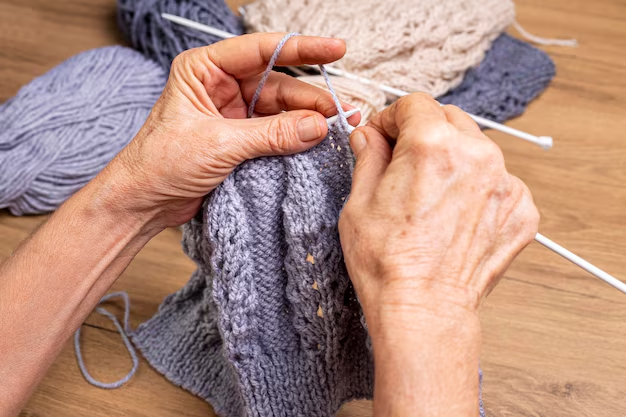Discovering the Joys of Knitting or Crocheting in Retirement: Your New Creative Journey
Retirement marks the beginning of a new chapter, a time when you can finally invest in passions that once took a backseat. If you've always found joy in creativity or have been searching for a calming activity to fill your days, knitting and crocheting may become your newfound loves. These crafts not only offer a sense of achievement but also foster a community of like-minded individuals eager to share their experiences. Here's how to embark on this colorful adventure.
Why Choose Knitting or Crocheting?
A Blend of Creativity and Relaxation
Knitting and crocheting are much more than hobbies—they're forms of artistic expression that offer therapeutic benefits. These activities engage fine motor skills, improve concentration, and provide a meditative escape through repetitive motions. As many crafters will attest, the rhythmic nature of these crafts can be incredibly soothing, reducing stress and promoting mental well-being.
- Key Benefits:
- Calming Effect: Helps in reducing anxiety and boosting mood.
- Cognitive Engagement: Keeps the mind sharp through pattern and design planning.
- Sense of Accomplishment: Completing a project provides a satisfying sense of achievement.
Creating Personalized Crafts
Knitting and crocheting allow you to produce unique, handmade items. Whether it's a cozy scarf, a warm blanket, or an intricate toy, each creation tells a story and can become a cherished gift for friends and family.
- Popular Projects:
- Blankets and Throws: Ideal for cozying up.
- Scarves and Shawls: Simple yet stylish.
- Amigurumi: Small, crocheted creatures popular among children and collectors.
Getting Started: What You Need
Basic Supplies
Embarking on your knitting or crocheting journey requires a few essentials. Fortunately, these crafts are beginner-friendly and don't need a hefty investment.
- Tools:
- Knitting needles or crochet hooks. They come in various sizes; for beginners, medium sizes (4-5 mm) are a good start.
- Yarn: Choose a soft, medium-weight yarn in a color you love. As you gain experience, you can experiment with different textures and materials.
- Accessories: A tapestry needle for finishing projects, stitch markers for keeping track of your work, and a measuring tape to ensure precise sizing.
Learning the Basics
There are countless resources available to help you learn, from classes at local craft stores to video tutorials online.
- Self-paced Learning: Websites and apps provide tutorials suitable for all skill levels, from casting on in knitting to creating chain stitches in crochet.
- In-person Classes: Engage with instructors and peers, which can enhance the learning process and introduce you to your community.
💡 Quick Tip: Start with simple projects like a dishcloth or a basic scarf to build confidence and familiarity with the techniques.
Deepening Your Skill Set: Patterns and Techniques
Understanding Patterns
Patterns are the roadmaps of knitting and crocheting. They provide instructions and diagrams that help transform yarn into breath-taking creations.
- Reading Patterns: Familiarize yourself with common abbreviations and symbols used in patterns. Each craft has its own set of instructions that, once learned, open up unlimited possibilities.
- Experimenting with Textures: Learning different stitches like stockinette or granny squares enhances your ability to diversify projects.
Expanding Your Creativity
Advanced Techniques:
- Colorwork: Incorporate multiple colors into your work using techniques like intarsia or Fair Isle.
- Lace and Cables: Create intricate designs that challenge and inspire.
Designing Your Own Patterns: With practice, you can begin customizing existing patterns or even create new ones, tailoring projects to your personal style.
Building a Community: Connection through Craft
Joining Craft Circles
Engaging with others who share your interest in knitting and crocheting can be an enriching experience. Craft circles offer both in-person and virtual options to connect.
- Benefits:
- Exchange tips and tricks with fellow crafters.
- Share project inspiration and collaborate on group challenges.
Exhibiting Your Work
Showcasing your work can serve as both motivation and recognition of your skill.
- Local Craft Fairs: Participate in events to meet other artisans and share your creations with the community.
- Online Platforms: Social media and craft websites provide outlets to display finished projects and gain feedback from a global audience.
🎨 Summary Tips:
- 🧶 Start Small: Begin with basic patterns to build your confidence.
- 📚 Continuous Learning: Engage with communities for shared learning experiences.
- 👩🎨 Experiment: Don’t be afraid to push your creativity with new techniques.
Overcoming Challenges: Common Hurdles and Solutions
Managing Mistakes
Mistakes happen, but they also present valuable learning opportunities.
- Identifying and Correcting: Practice patience when facing errors. Learn techniques like tinking (unknitting) or "frogging" (ripping back) your stitches to correct mistakes.
- Learning from Experience: Each error teaches you more about the craft. Embrace them as steps towards mastery.
Avoiding Common Pitfalls
- Gauge Swatching: Skipping this step can lead to inconsistent sizing. Always check your gauge before starting a new project.
- Yarn Care: Follow care instructions to maintain the quality and longevity of your creations.
Conclusion: Embrace Your Creative Journey
Knitting and crocheting in retirement offer more than a pastime—they build a bridge to a vibrant community, nurture creativity, and provide a sense of peace and accomplishment. Whether you're crafting solo or joining a circle of fellow enthusiasts, every stitch is a step in your continuous journey of discovery and self-expression. Explore the endless possibilities these crafts offer and knit, or crochet, your way to a fulfilling retirement.

Related Topics
- Creative Writing Ideas For Seniors
- How To Get Involved In Local History As a Senior
- How To Join a Community Theater Group In Retirement
- How To Join a Senior Art Class
- How To Join a Walking Club For Seniors
- How To Learn a New Language In Retirement
- How To Learn a New Skill After 60
- How To Learn An Instrument In Retirement
- How To Start a Cooking Hobby As a Senior
- How To Start a Crafting Hobby As a Senior